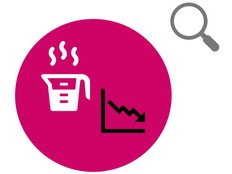Stap 1: Voorbereiden
Wat is het?
Onderzoek materialen om te zien of ze transparant, doorzichtig of ondoorzichtig zijn met een zaklamp en twee BBC micro:bits.
Dit project is ontwikkeld in partnerschap met Witte Rose Wetenschap voor wetenschapsleraren en stelt studenten in staat om de eigenschappen van materialen te onderzoeken en het effect van het plaatsen van objecten op het pad van een lichtstraal. Leerlingen kunnen ook leren over het gebruik van sequenties, variabelen en lussen in een computerprogramma.
Deze video legt uit hoe het project werkt en hoe het experiment moet worden uitgevoerd.
Zo werkt het
- Dezelfde code wordt gebruikt op beide micro:bits.
- Een micro:bit wordt in een doos geplaatst terwijl de andere bij jou blijft.
- Je bedekt het open uiteinde van de doos met de verschillende materialen die je aan het testen bent en schijnt met een zaklamp door de materialen in de doos.
- De micro:bit in de doos meet het licht dat het materiaal binnendringt en stuurt zijn metingen via de radio naar de micro:bit in de kamer.
- De micro:bit in de ruimte geeft de lichtmetingen weer.
- De metingen variëren van 0 (volledig donker) tot 100 (zeer helder). Lagere metingen suggereren ondoorzichtigheid en hogere metingen wijzen op transparantie.
Benodigdheden
- een zaklamp
- een lange smalle doos, papieren beker of kartonnen buis met het deksel verwijderd
- materiaal om te testen zoals een stuk papier, bubbeltjesplastic, vilt en een heldere kunststof mouw, die elk groot genoeg is om het open uiteinde van de doos te bedekken
- twee micro:bits
- minstens één batterijpakket met nieuwe batterijen
Stap 2: Onderzoek
- Download het hex-bestand en zet de code op beide micro:bits. Je hoeft de code voor dit project zelf niet te schrijven om het experiment te kunnen doen, maar als je geïnteresseerd bent in coderen, bekijk dan de stap 3: Codeer het gedeelte hieronder.
- Voeg een batterijpakket toe aan op zin minst één micro:bit. Plaats de micro:bit met het batterijpakket op de bodem van de doos met de LEDs naar boven gericht. Plaats het batterijpakket onder de micro:bit zodat deze het licht niet blokkeert.
- Zet de zaklamp aan en houd hem bij de opening van de doos, maar niet erin. Druk op knop B op de micro:bit in de ruimte om het lichtniveau aan de onderkant van de doos te meten. Noteer de meting. Voor de nauwkeurigheid doe je de test drie keer en reken je het gemiddelde uit. Dit is je controle meting. die je als referentie zou moeten nemen, omdat jouw maximale lichtmetingen afhankelijk zijn van de kracht van jouw zaklamp.
- Plaats nu een stuk van het materiaal dat je aan het testen bent over het uiteinde van de doos. Schijn met de zaklamp door het materiaal, houd hem in dezelfde positie met betrekking tot de doos als voorheen. Druk nogmaals op knop B en neem noteer de meting.
- Herhaal voor andere materialen.
- Vergelijk je resultaten. Zijn ze wat je verwachtte?
Tips
- Misschien wil je dit onderzoek samen met iemand anders uitvoeren, want het kan moeilijk zijn om tijdens het doen van metingen de zaklamp en het materiaal vast te houden.
- Als je onverwachte metingen van 0 krijgt tijdens het onderzoek, probeer dan de accupakketten los te koppelen en opnieuw aan te sluiten of druk op de reset-knop aan de achterkant van de micro:bits.
- Sommige materialen laten licht door dat de micro:bit niet detecteert. Plaats de zaklamp tegen het voorbeeldmateriaal om de beste resultaten te bereiken.
- Twee-cijferige getallen scrollen over het micro:bit LED-scherm. Moedig leerlingen aan om te oefenen met het lezen van getallen van het scherm voor het experiment begint.
Dit experiment doen in een klas of coderingsclub
Als je dit experiment doet in een klas of coderingsclub, dan moet elk paar micro:bits verschillende overeenkomende radio-groepnummers hebben. Dit zorgt ervoor dat elke ontvangende micro:bit de metingen van de juiste zendende micro:bit ontvangt.
Open het project in Microsoft MakeCode en voer een uniek nummer in in het radio installen groep-blok, download dat hex-bestand vervolgens naar twee micro:bits. Hou ze samen met een elastische band of in een kleine zak. Herhaal voor elk paar micro:bits die worden gebruikt in de klas.
Stap 3: Codeer het
Bekijk deze video om te zien hoe je het project kunt coderen:
Als je geïnteresseerd bent in het wijzigen van de code voor dit project, klik dan op een van de knoppen hieronder:
This content is published under a Creative Commons Attribution-ShareAlike 4.0 International (CC BY-SA 4.0) licence.



